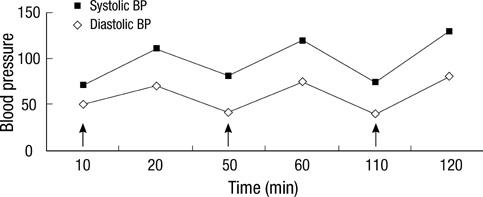J Korean Med Sci.
2010 Aug;25(8):1231-1233. 10.3346/jkms.2010.25.8.1231.
A Case of Anaphylaxis to Oral Minocycline
- Affiliations
-
- 1Department of Internal Medicine, University of Ulsan College of Medicine, Asan Medical Center, Seoul, Korea.
- 2Division of Allergy and Clinical Immunology, University of Ulsan College of Medicine, Asan Medical Center, Seoul, Korea.
- KMID: 1714049
- DOI: http://doi.org/10.3346/jkms.2010.25.8.1231
Abstract
- Minocycline is a semisynthetic tetracycline derivative that is often used in the treatment of acne vulgaris. To date, there has been only one case report of anaphylaxis to minocycline. We report here a case of anaphylaxis to oral minocycline. A 56-yr-old woman visited our hospital after three episodes of recurrent anaphylaxis. We performed an oral challenge test, the standard method for diagnosing drug allergies, with minocycline, one of the drugs she had taken previously. She developed urticaria, angioedema, nausea, vomiting, hypotension, and dyspnea within 4 min and was treated with intramuscular epinephrine, intravenous antihistamine and systemic corticosteroid. However, she presented similar symptoms at 50 min and at 110 min. In prescribing oral minocycline, physicians should consider the possibility of serious adverse reactions, such as anaphylaxis.
Keyword
MeSH Terms
Figure
Cited by 1 articles
-
Overview of anaphylaxis in Korea: diagnosis and management
Gwang Cheon Jang, Yoon-Seok Chang, Sun Hee Choi, Woo-Jung Song, Soo-Young Lee, Hae-Sim Park, Hye-Ryun Kang, Yeong-Min Ye, Hyun-Jung Jin, Mi Yong Shin, Soo-Jin Lee, Hye One Kim, Jihyun Kim, Jae-Woo Jung, Hee-Bom Moon, Youngmin Ahn
Allergy Asthma Respir Dis. 2013;1(3):181-196. doi: 10.4168/aard.2013.1.3.181.
Reference
-
1. Adkinson NF Jr, Essayan D, Gruchalla R, Haggerty H, Kawabata T, Sandler JD, Updyke L, Shear NH, Wierda D. Task force report: future research needs for the prevention and management of immune-mediated drug hypersensitivity reactions. J Allergy Clin Immunol. 2002. 109:S461–S478.
Article2. Lazarou J, Pomeranz BH, Corey PN. Incidence of adverse drug reactions in hospitalized patients: a meta-analysis of prospective studies. JAMA. 1998. 279:1200–1205.
Article3. McCaig LF, Hughes JM. Trends in antimicrobial drug prescribing among office-based physicians in the United States. JAMA. 1995. 273:214–219.
Article4. Barnett CF Jr. Anaphylactoid reaction to orally administered tetracycline. South Med J. 1967. 60:963.
Article5. Goulden V, Glass D, Cunliffe WJ. Safety of long-term high-dose minocycline in the treatment of acne. Br J Dermatol. 1996. 134:693–695.
Article6. Clayton BD, Hitchcock MG, Williford PM. Minocycline hypersensitivity with respiratory failure. Arch Dermatol. 1999. 135:139–140.
Article7. Colvin JH, Sheth AP. Minocycline hypersensitivity syndrome with hypotension mimicking septic shock. Pediatr Dermatol. 2001. 18:295–298.
Article8. Okano M, Imai S. Anaphylactoid symptoms due to oral minocycline. Acta Derm Venereol. 1996. 76:164.9. Chaudhuri K, Gonzales J, Jesurun CA, Ambat MT, Mandal-Chaudhuri S. Anaphylactic shock in pregnancy: a case study and review of the literature. Int J Obstet Anesth. 2008. 17:350–357.
Article10. Raeder JC. Anaphylactoid reaction caused by intravenous doxycycline during general anesthesia and beta-blockade treatment. Drug Intell Clin Pharm. 1984. 18:481–482.11. Knowles SR, Shapiro L, Shear NH. Serious adverse reactions induced by minocycline. Report of 13 patients and review of the literature. Arch Dermatol. 1996. 132:934–939.
Article
- Full Text Links
- Actions
-
Cited
- CITED
-
- Close
- Share
- Similar articles
-
- Exfoliative Dermatitis Induced by Minocycline
- Confluent and Reticulated Papillomatosis Successfully Treated with Minocycline
- Comparative Study of Oral Minocycline Treatment and Intraprostatic Fosfomycin Injection on Nonbacterial Prostatitis
- A Case of Black Hairy Tongue Associated with Minocycline
- Cutaneous Silicone Granuloma Treated with Oral Minocycline and Intralesional Injection of Triamcinolone Acetonide



